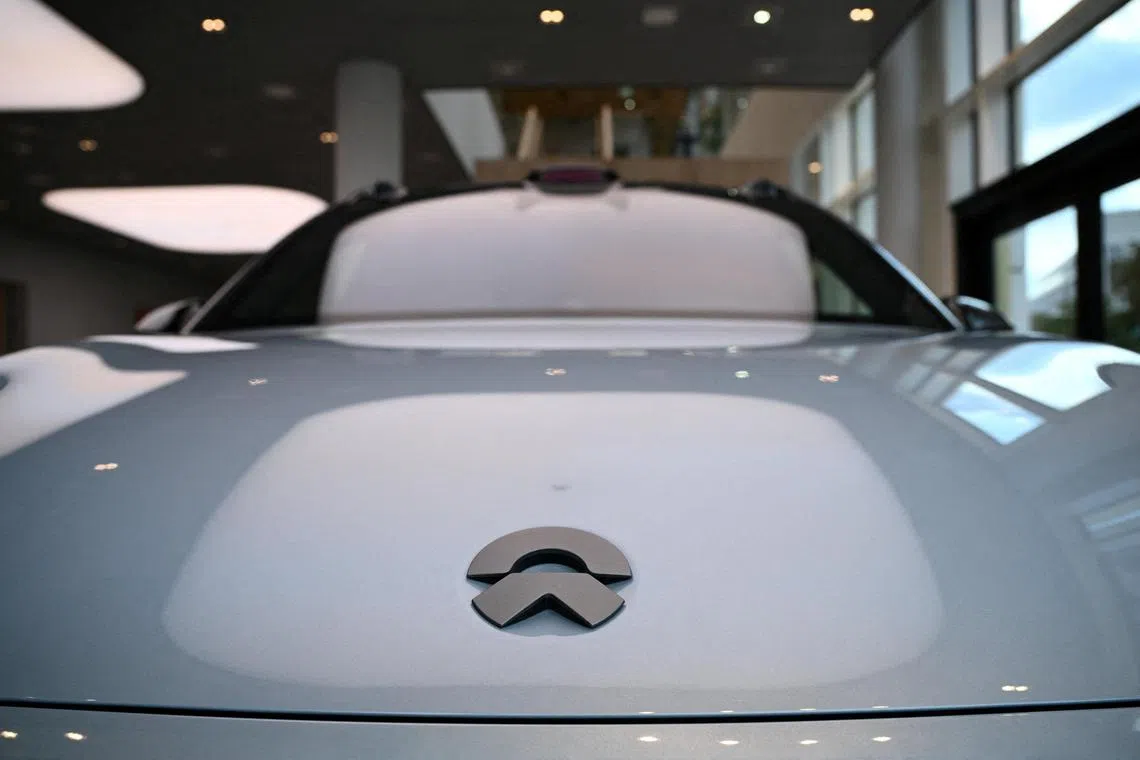China pulls its punches to keep pricey electric cars flowing to EU
Sign up now: Get ST's newsletters delivered to your inbox

Nio's EL6 car model at the showroom of the Chinese electric vehicle manufacture in Berlin, Germany.
PHOTO: REUTERS
Follow topic:
Munich – When the European Union launched a probe into Chinese support for electric vehicles (EVs),
The dire reprisal has not materialised, at least yet. Beyond some initial strong words from China,
The muted response points to the pressure China’s oversupplied EV market is under, made worse by the price war Tesla touched off over the past year.
After years of frenetic development in China, local carmakers are shipping a rising number of EVs to Europe, following a number of failed attempts to win customers in the home of Volkswagen (VW) and Renault.
While its Chinese manufacturers’ market share in Europe is still low, dominance in plug-in vehicle production has put the country in position to challenge Japan for the global lead in automotive exports.
“The Chinese would be shooting themselves in the foot if they were to retaliate and worsen relations with one of their biggest trading partners,” said Mr Matthias Schmidt, an independent auto analyst near Hamburg. “China has arrived at a point where they need to start selling more cars outside of their borders.”
EVs made in China, such as BYD’s Dolphin compact crossover and SAIC-owned MG Motor’s MG 4, fetch roughly double on average in Europe compared with their home region, customs data shows.
The price disparity stems from factors including China’s low labour costs and generous subsidies, and the additional costs companies have to absorb when sending cars overseas, including tariffs and shipping expenses.
The Dolphin retails from 111,000 yuan (S$20,800) in China.
Buyers in Germany have to fork out €35,990 (S$52,500), though that is still well below the entry price for VW’s ID.3. In Thailand, where EVs are starting to take off, customers pay the equivalent of US$19,560 (S$26,000) for an entry-level Dolphin.
It is similar at MG Motor. The Chinese brand with British cachet has been building a presence in Europe for over a decade and is leading among Chinese marques in the region. The MG 4, made in Ningde, Fujian province, sells at €37,700 in Germany – €20,000 more than in China.
Tesla’s Shanghai-made Model 3 is about €13,000 more expensive in the EU than in China.
Keeping the door open to lucrative Europe matters now more than ever, with the United States largely off limits because of a 25 per cent import tariff and generous purchasing incentives available only for vehicles made in North America.
At stake is the future of hundreds of unprofitable EV makers that have sprung up in the wake of sweeping government subsidies and inner-city driving restrictions.
The fight for survival is well under way.
Nio, once a leader among China’s EV newbies, is considering more staff cuts after an initial round shedding 10 per cent of its workers.
The company this week got another cash injection from the Middle East.
WM Motor has filed for bankruptcy after getting pushed to the sidelines in the cut-throat competition.
In China, the glut of EVs is unlikely to ease with BYD ratcheting up sales of EVs and plug-in hybrids by 65 per cent through November, putting the local leader on track for three million units in 2023.
At the same time, rising personal debt and slower income growth triggered by the country’s lengthy pandemic lockdowns and property sector crisis have capped spending.
“The Chinese government gave some support in the early stages of this industry, but it’s gradually winding down now,” said China Association of Automobile Manufacturers deputy chief engineer Xu Haidong. “Overseas manufacturers started later, and their products and technology are relatively behind.”
The EU’s probe kicked off in earnest in October with investigations of BYD, SAIC and Geely, bringing the bloc more in line with the US in looking to protect an industry that employs millions of workers.
While the EU is pursuing extra duties, the US is dishing out a swath of subsidies to attract investments with strict rules on local supply chains and EV making to qualify for incentives.
Initial tariffs could come as early as July, with any final decision requiring approval from member states. Any punitive EV tariffs would come on top of a current 10 per cent import duty.
At December’s trade talks, the first in-person summit in four years, Chinese officials took a non-aggressive stance.
President Xi Jinping told EU leaders that he wants the two sides to be key trade partners capable of building trust over supply chains. China’s Ministry of Commerce separately said the EU should stop trade protectionism through the EV probe.

Robots and workers assemble electric vehicles at a new factory run by Nio, a Chinese automaker, in Hefei, China.
PHOTO: NYTIMES
To be sure, Western carmakers including Tesla, Renault and BMW would likewise be hit by higher duties as they ship cars from the world’s biggest auto market to Europe.
China’s stance could also shift should tariffs be imposed, with painful consequences for global carmaking.
BMW, Mercedes-Benz and VW sell between 33 per cent to 40 per cent of their vehicles there, and no manufacturer can get by without China’s EV batteries and other components. In a potential foretaste in October, China restricted exports of graphite, used to make batteries.
“The most obvious option to retaliate would be to take the import tariff into China from 15 per cent back to 25 per cent,” said Council of Foreign Relations senior fellow Brad Setser. “China would be well within its right to do so.” BLOOMBERG

